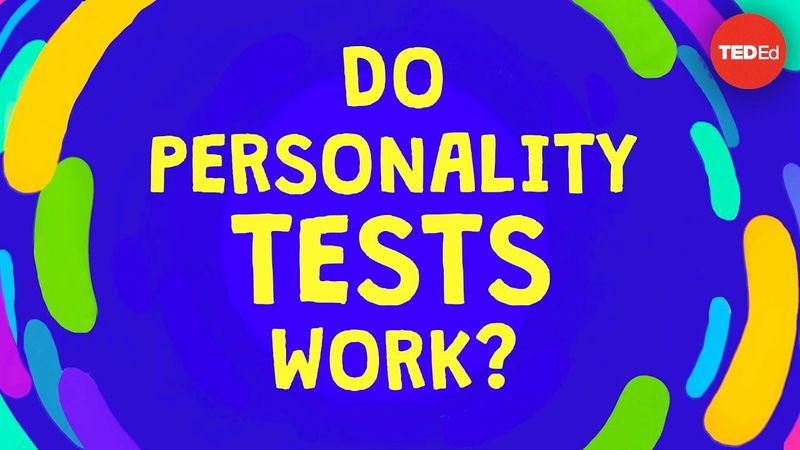Ep. 8 | แบบทดทดสอบบุคลิกภาพบอกบุคลิกภาพได้จริงหรือเปล่า? Part 1/2
👉
ในช่อง YouTube ของ TED-Ed มีวิดีโอชื่อ Do personality tests work? (https://youtu.be/lN7Fmt1i5TI) ซึ่งพูดถึงเหตุผล 6 ข้อหลักที่แสดงให้เห็นว่า แบบทดสอบบุคลิกภาพ (personality test) ไม่สามารถประเมินบุคลิกภาพได้จริง
ใน 2 บทความจากนี้ เราจะมาพูดถึงเหตุผลทั้ง 6 ข้อ เพื่อหาข้อสรุปว่า แบบทดสอบบุคลิกภาพสามารถประเมินบุคลิกภาพได้จริงหรือไม่? โดยใน Part 1 เราจะพูดถึง 3 เหตุผลแรก และอีก 3 เหตุผลหลังใน Part 2
(ที่มา: TED-Ed: https://youtu.be/lN7Fmt1i5TI)
.
😫 1. เหตุผลที่ 1: ความหลากหลายของกรอบแนวคิด
.
🤔 1.1. เหตุผล
ในตอนต้นของวิดีโอ จะเห็นได้ว่า มีหลายกรอบแนวคิดที่พยายามจำแนกประเภทบุคลิกภาพ ทั้ง MBTI, DISC, Big Five, PCM, และแม้กระทั่ง Enneagram
(สำหรับคนที่ไม่รู้จักชื่อและตัวย่อเหล่านี้ ทั้งหมดเป็นกรอบแนวคิดบุคลิกภาพ ซึ่งจะไม่ขอลงรายละเอียดในบทความนี้ แต่สามารถ Google เพื่ออ่านเพิ่มเติมได้)
แต่ละกรอบแนวคิดมีมุมมองที่ไม่ตรงกันเกี่ยวกับจำนวนบุคลิกภาพ เช่น MBTI จำแนกคนออกเป็น 16 ประเภท ส่วน DISC แบ่งออกเป็น 4 ประเภท
ความแตกต่างของกรอบแนวคิดต่าง ๆ ทำให้เกิดคำถามว่า จริง ๆ แล้วบุคลิกภาพมีกี่แบบและมีอะไรบ้าง? แล้วแบบทดสอบที่ใช้กรอบแนวคิดไหนที่ถือว่า ถูกต้องที่สุด (สามารถประเมินบุคลิกภาพจริง ๆ ได้)?
และด้วยคำถามเหล่านี้ ในวิดีโอจึงสรุปว่า แบบทดสอบบุคลิกภาพไม่สามารถประเมินบุคลิกภาพได้จริง
.
💡 1.2. ข้อมูลจากงานวิจัย
จริงอยู่ว่า ในปัจจุบันมีกรอบแนวคิดบุคลิกภาพที่หลากหลาย แต่เป็นเวลาหลายสิบปีแล้วที่นักจิตวิทยาให้การยอมรับใน Big Five กรอบแนวคิดที่ระบุว่า บุคลิกภาพของมนุษย์แบ่งออกเป็น 5 ลักษณะหลัก ว่า เป็นกรอบแนวคิดสากลที่สามารถใช้ในการอธิบาย จัดกลุ่ม และประเมินบุคลิกภาพของมนุษย์ได้ (Chamorro-Premuzic, 2023; John et al., 2008)
ดังนั้น การที่บอกว่า แบบทดสอบบุคลิกภาพไม่สามารถประเมินบุคลิกภาพได้เพราะไม่มีกรอบแนวคิดที่แน่นอน เป็นการให้เหตุผลที่ไม่มีน้ำหนัก
แล้วการที่ Big Five เป็นที่ยอมรับอย่างกว้างขวางหมายถึงว่า แบบทดสอบที่ใช้กรอบแนวคิดอื่น เช่น MBTI และ DISC ไม่ได้วัดบุคลิกภาพด้วยหรือเปล่า?
คำตอบสำหรับคำถามนี้ ขึ้นอยู่กับลักษณะทางไซโคเมตริก (psychometric หรือลักษณะทางสถิติของแบบวัดทางจิตวิทยา) ของแบบทดสอบแต่ละตัวว่า มีความเที่ยง (reliability คือ สามารถให้คะแนนที่เสมอต้นเสมอปลายได้หรือเปล่า) และความตรง (validity คือ สามารถประเมินปัจจัยที่ถูกออกแบบมาให้ประเมินได้หรือเปล่า)
ถ้าหากว่า แบบทดสอบเหล่านี้มีความเที่ยงและความตรงสูง คือ ให้คะแนนที่เสมอต้นเสมอปลายไม่ว่าจะทดสอบกี่ครั้ง และมีหลักฐานว่าประเมินในสิ่งที่ต้องการประเมินจริง ๆ (เช่น วัดตัวแปร introvert-extrovert ของ MBTI) ก็อาจบอกได้ว่า แบบทดสอบเหล่านี้สามารถวัดบุคลิกภาพได้
(ที่มา: TED-Ed: https://youtu.be/lN7Fmt1i5TI)
.
😔 2. เหตุผลที่ 2: คนสามารถ “โกง” แบบทดสอบได้
.
🤔 2.1. เหตุผล
แบบทดสอบบุคลิกภาพมักอยู่ในรูปแบบของการประเมินตัวเอง (self-report) ที่ผู้ทำแบบทดสอบสามารถบิดเบือนคำตอบของตัวเองได้
ตัวอย่างเช่น ข้อคำถามของ NEO-PI-3 (McCrae et al., 2005) ที่พัฒนาตามกรอบแนวคิด Big Five ที่เขียนว่า “ฉันไม่ใช่คนชอบขี้อวด (I’m not a showoff)” ผู้ทำแบบทดสอบสามารถเลือกที่จะตอบ “ไม่เห็นด้วย” แม้ว่าจริง ๆ แล้วอาจจะไม่ใช่คนที่อ่อนน้อมถ่อมตนก็ตาม
การที่ผู้ทำแบบทดสอบสามารถบิดเบือนคำตอบได้ ทำให้แบบทดสอบเสียความตรงไป นั่นคือ แบบทดสอบไม่ได้ประเมินที่สิ่งที่ถูกออกแบบมาให้ประเมิน
อย่างในกรณีตัวอย่าง แทนที่แบบทดสอบนี้จะประเมินความเตรียมพร้อม แต่อาจประเมินความพึงประสงค์ทางสังคม (social desirability) แทนได้
ด้วยเหตุนี้ ในวิดีโอจึงสรุปว่า แบบทดสอบบุคลิกภาพไม่สามารถประเมินบุคลิกภาพได้
.
💡 2.2. ข้อมูลจากงานวิจัย
งานวิจัยสนับสนุนความคิดที่ว่า แบบทดสอบบุคลิกภาพสามารถถูกโกงได้
ยกตัวอย่างเช่น Furnham (1990) ขอให้ผู้เข้าร่วมการศึกษาทำแบบทดสอบ 4 ครั้ง โดย 1 ครั้งขอให้ตอบอย่างจริงใจ และอีก 3 ครั้ง ขอให้โกงคำตอบเหมือนกับว่า กำลังจะสมัครงานบรรณารักษ์ นักโฆษณา และนายธนาคาร
ผลลัพธ์พบว่า คะแนนแบบทดสอบแตกต่างกันไปตามอาชีพที่ขอให้โกง เช่น บรรณารักษ์มีคะแนน introversion สูง นักโฆษณามีหัวศิลป์สูง และนายธนาคารมีความละเอียดสูง ซึ่งแสดงให้เห็นว่า แบบทดสอบบุคลิกภาพสามารถถูกบิดเบือนได้ตามความต้องการของผู้ทำแบบทดสอบ
อย่างไรก็ตาม แม้ว่าจะถูกโกงได้ แต่ไม่จำเป็นว่า แบบทดสอบจะไม่สามารถประเมินบุคลิกภาพได้เลย ด้วย 2 เหตุผล
(1) การโกงได้ ไม่ได้หมายความว่า การโกงจะเกิดขึ้นในโลกจริง (Schwab, 1971)
เพราะต้องไม่ลืมว่า ในงานของ Furnham ผู้เข้าร่วมได้รับคำชี้แจงให้บิดเบือนคำตอบ ซึ่งในการโลกจริง มีความเป็นไปได้น้อยที่จะมี HR เดินมาบอกผู้สมัครให้โกงแบบทดสอบให้ได้คะแนนดี
นอกจากนี้ เหตุผลนี้มีงานวิจัยสนับสนุนแนว โดยแสดงให้เห็นว่า ผลของการโกงในโลกจริงเกิดขึ้นน้อยกว่าในห้องทดลอง (Birkeland et al., 2006)
(2) ที่สำคัญกว่านั้น งานวิจัยจำนวนมากแสดงให้เห็นว่า การโกงไม่ได้ส่งผลอย่างมีนัยสำคัญต่อความตรงของแบบทดสอบ
ยกตัวอย่างเช่น Hogan และคณะ (2007) ให้ผู้สมัครงานทำแบบทดสอบ 2 ครั้ง (ครั้งแรกเมื่อสมัครงานและถูกปฏิเสธ และครั้งที่ 2 ในเวลา 6 เดือนต่อมา) จากการตรวจสอบคะแนนพบร่องรอยของการโกง นั่นคือ ผู้สมัครมีคะแนนที่เปลี่ยนไปเกินระดับที่กำหนด อย่างไรก็ตาม เมื่อนำคะแนนของผู้สมัครมาวิเคราะห์ พบว่าคะแนนทั้งจากครั้งที่ 1 และ 2 มีค่าความตรงที่ไม่แตกต่างกัน
ในลักษณะเดียวกัน Li และ Bagger (2006) ควบคุมอิทธิพลของการบิดเบือนคำตอบด้วยวิธีการทางสถิติ และพบว่า ความสัมพันธ์ระหว่างคะแนนบุคลิกภาพและผลลัพธ์ในการทำงานไม่เปลี่ยนแปลง
งานวิจัยอื่น ๆ (เช่น Ellingson et al., 2001; Paunonen & LeBel, 2012; Rosse et al., 1998) ได้ผลในลักษณะเดียวกับ Hogan และคณะ และ Li และ Bagger ซึ่งทั้งหมดชี้ให้เห็นว่า แม้ว่าแบบทดสอบบุคลิกภาพจะถูกโกงได้ แต่การโกงส่งผลน้อยมากต่อความสามารถในการประเมินบุคลิกภาพของแบบทดสอบบุคลิกภาพ
ดังนั้น การโกงจึงเป็นเหตุผลที่ไม่มีน้ำหนักในการวิจารณ์ว่า แบบทดสอบบุคลิกภาพไม่สามารถวัดบุคลิกภาพได้
(ที่มา: TED-Ed: https://youtu.be/lN7Fmt1i5TI)
😖 3. เหตุผลที่ 3: Forced-Choice
.
🤔 3.1. เหตุผล
แบบทดสอบบุคลิกภาพที่เป็นแบบประเมินตัวเอง มีรูปแบบการตอบที่หลากหลาย ซึ่งรูปแบบที่พูดถึงก่อนหน้านี้ เรียกว่า Likert scale ที่ผู้ทำแบบทดสอบประเมินตัวเองบนเกณฑ์ที่มีคะแนนกำกับ (เช่น ถ้าตอบ “เห็นด้วย” ได้ 1 คะแนน และตอบ “ไม่เห็นด้วย” ได้ 0 คะแนน)
ยังมีการตอบอีกรูปแบบ คือ forced-choice ซึ่งในรูปแบบนี้ ผู้ทำแบบทดสอบจะได้รับข้อความที่สะท้อนถึงบุคลิกภาพที่มีความน่าพึงประสงค์ทางสังคมในระดับเดียวกัน (เช่น “ความซื่อสัตย์” และ “ความขยัน”) และสามารถเลือกตอบได้ข้อเดียวเท่านั้น (เช่น เลือกแค่ “ความซื่อสัตย์” หรือ “ความขยัน” อย่างใดอย่างหนึ่ง)
ข้อดีของ forced-choice คือ ช่วยป้องกันการโกง (Cao & Drasgow, 2019; Martínez & Salgado, 2021) เพราะไม่ว่าจะบิดเบือนคำตอบยังไง ผู้ทำแบบทดสอบก็มีแต่เสียกับเสีย (เช่น เลือกได้อย่างเดียวว่า จะเป็นคนซื่อสัตย์หรือคนขยัน)
อย่างไรก็ตาม ข้อเสียของ forced-choice คือ ทำให้ค่าความสัมพันธ์ระหว่างตัวแปรลดลง ซึ่งทำให้ความตรงของแบบทดสอบบุคลิกภาพลดลงด้วย (Hicks, 1970)
ซึ่งไม่น่าแปลกใจที่ในวิดีโอระบุว่า คนที่ทำแบบทดสอบบุคลิกภาพแบบ forced-choice ซ้ำ ๆ มีโอกาสได้คะแนนไม่เหมือนกัน ทำให้เกิดความเคลือบแคลงใจว่า แบบทดสอบบุคลิกภาพประเมินบุคลิกภาพได้จริงหรือไม่
.
💡 3.2. ข้อมูลจากงานวิจัย
อย่างไรก็ตาม ข้อจำกัดเรื่องความเที่ยงและความตรงถูกจำกัดอยู่เฉพาะแบบทดสอบที่ใช้ forced-choice เท่านั้น ซึ่งแบบทดสอบบุคลิกภาพที่น่าเชื่อถือส่วนใหญ่มักใช้ Likert scale เช่น NEO-PI (เช่น McCrae et al., 2005) ซึ่งประเมิน Big Five ซึ่งมักใช้บริบทงานวิจัย และ Hogan Personality Inventory (Hogan & Hogan, 2007) ซึ่งประเมิน Big Five เช่นกันและเป็นแบบประเมินที่มักใช้ในกับผู้บริหารและผู้นำองค์กร
(แต่ไม่ใช่กับ MBTI* ซึ่งในวิดีโอยกมาเป็นตัวอย่างของเหตุผลนี้)
ดังนั้น การที่บอกว่า แบบทดสอบบุคลิกภาพไม่สามารถประเมินบุคลิกภาพได้เพราะใช้ forced-choice จึงจำกัดอยู่กับแบบทดสอบที่ใช้การตอบรูปแบบนี้เท่านั้น
⏭️ 4. ตอนต่อไป
ใน Part 2 เราจะพูดถึงเหตุผลอีก 3 ข้อที่บอกว่า แบบทดสอบบุคลิกภาพไม่สามารถประเมินบุคลิกภาพได้จริง พร้อมกับบทสรุปของทั้ง 2 parts
⚡ หมายเหตุ
* แม้ว่าจะเป็นแบบทดสอบบุคลิกภาพที่เป็นที่รู้จักอย่างแพร่หลาย แต่ MBTI ไม่ใช่แบบทดสอบที่ดี (Chamorro-Premuzic, 2023; Grant, 2015; Pittenger, 2005) ซึ่งถ้าวิดีโอที่เป็นต้นเรื่องของบทความนี้ไม่ยกตัวอย่างจาก MBTI แต่จากแบบทดสอบอื่น ๆ เช่น NEO-PI และ Hogan Personality Inventory เราก็คงไม่มีบทความนี้เกิดขึ้น 😁
#psychology #individualdifferences #personality #personalitytest #personalityscale #personalityinventory #bigfive #ffm #fivefactormodel #mbti #myersbriggstypeindicator #psychometrics #psychometric #teded #ted-ed #จิตวิทยา #บุคลิกภาพ
📃 อ้างอิง
Birkeland, S. A., Manson, T. M., Kisamore, J. L., Brannick, M. T., & Smith, M. A. (2006). A meta-analytic investigation of job applicant faking on personality measures. International Journal of Selection and Assessment, 14(4), 317–335. https://doi.org/10.1111/j.1468-2389.2006.00354.x
Cao, M., & Drasgow, F. (2019). Does forcing reduce faking? A meta-analytic review of forced-choice personality measures in high-stakes situations. Journal of Applied Psychology, 104(11), 1347–1368. https://doi.org/10.1037/apl0000414
Chamorro-Premuzic, T. (2023, August 4). Eight popular misconceptions about personality. Forbes. https://www.forbes.com/sites/tomaspremuzic/2023/08/01/eight-popular-misconceptions-about-personality/?sh=435411552b0b
Ellingson, J. E., Smith, D. B., & Sackett, P. R. (2001). Investigating the influence of social desirability on personality factor structure. Journal of Applied Psychology, 86(1), 122–133. https://doi.org/10.1037/0021-9010.86.1.122
Furnham, A. (1990). Faking personality questionnaires: Fabricating different profiles for different purposes. Current Psychology, 9(1), 46–55. https://doi.org/10.1007/BF02686767
Hicks, L. E. (1970). Some properties of ipsative, normative, and forced-choice normative measures. Psychological Bulletin, 74(3), 167–184. https://doi.org/10.1037/h0029780
Hogan, J., Barrett, P., & Hogan, R. (2007). Personality measurement, faking, and employment selection. Journal of Applied Psychology, 92(5), 1270–1285. https://doi.org/10.1037/0021-9010.92.5.1270
Hogan, R., & Hogan, J. (2007). Hogan Personality Inventory manual (3rd ed.). Hogan Assessment Systems.
John, O. P., Naumann, L. P., & Soto, C. J. (2008). Paradigm shift to the integrative Big Five trait taxonomy: History, measurement, and conceptual issues. In O. P. John, R. W. Robins, & L. A. Pervin (Eds.), Handbook of personality: Theory and research (pp. 114–158). The Guilford Press.
Martínez, A., & Salgado, J. F. (2021). A meta-analysis of the faking resistance of forced-choice personality inventories. Frontiers in Psychology, 12. https://doi.org/10.3389/fpsyg.2021.732241
McCrae, R. R., Costa, P. T., Jr., & Martin, T. A. (2005). The NEO-PI-3: A more readable Revised NEO Personality Inventory. Journal of Personality Assessment, 84(3), 261–270. https://doi.org/10.1207/s15327752jpa8403_05
Paunonen, S. V., & LeBel, E. P. (2012). Socially desirable responding and its elusive effects on the validity of personality assessments. Journal of Personality and Social Psychology, 103(1), 158–175. https://doi.org/10.1037/a0028165
Rosse, J. G., Stecher, M. D., Miller, J. L., & Levin, R. A. (1998). The impact of response distortion on preemployment personality testing and hiring decisions. Journal of Applied Psychology, 83(4), 634–644. https://doi.org/10.1037/0021-9010.83.4.634
Schwab, D. P. (1971). Issues in response distortion studies of personality inventories: A critique and replicated study. Personnel Psychology, 24(4), 637–647. https://doi.org/10.1111/j.1744-6570.1971.tb00377.x
ภาพปก: Image by Freepik
ดูเพิ่มเติมในซีรีส์
โฆษณา
- ดาวน์โหลดแอปพลิเคชัน
- © 2025 Blockdit



